Sat, 03 Sep 2005 10:15 AM
This week I've had a bit of a chance to play with some new hardware I was given. I am well enough to be up and doing stuff again, its great :)Routing
Michael Dale
So yeah I've picked up a Cisco 2611 and Cisco 827-4v router.
The first one is a modular router that has two 10mbit Ethernet ports, it has been upgraded to 64mb and has a fairly new IOS on it. The 827 is an ADSL1 router with 4 analog telephone adapters (ATA) built in.
I'm trying to setup a RIP routing network between the 2611 and a OpenBSD box. I'm currently looking at two pieces of software to do this, Zebra and Xorp. These both sit on top of another operating system and handle routing.
It has been pretty interesting. I have been impressed with the Cisco gear. Once you'd had a real chance to play with it they work well. I like how the whole configuration is in one file, that makes life nice and easy.
I did do CCNA way back at school, but I'm required to do some Cisco stuff at UNI and I need to refresh my memory.
On another topic. I've run out of Ethernet ports at home, so I thought I'd spend a bit of money and get myself a cheap 24 port 100mbit managed switch. The switch I have purchased also does basic vlans, so that should be very helpful. The switch has cost me about $160 (yes very cheap) and can be found here. I should get that in the next week or so.
Sat, 27 Aug 2005 11:38 AM
Tom Quinn has successfully put together a working copy of rdesktop for the IBM thin client. I have repackaged it into a tar.gz and have since tested it on my thin client.rdesktop for N2200 with Linux-2200
Michael Dale
To install download this file to your thin client in the root of the drive /
http://michaeldale.com.au/files/N2200/rdesktop-linux2200.tar.gz
then from a command line run:
You should now be able to start rdesktop by running it from /usr/bin/rdesktop.
The command I use to start it is:
Now Tom said that he had problems getting it into full screen, I did not have this problem. Let me know if it is a problem for you.
Also the key mapping for the backspace key still does not work. When I get a chance I will look into it.
If you'd like this to run on startup modify .xinitrc in root and add the rdesktop start command.
Tue, 23 Aug 2005 1:32 PM
Sun, 07 Aug 2005 9:31 PM
I thought the documentation on installing Linux onto the N2200 wasn’t great so I decided to write up something myself.Installing "Linux-2200" onto the IBM Netvista N2200 (8363)
Michael Dale
Please note that I did not write or compile this software, the original source of this program can be found here.
Things you’ll need:
- A Netvista N2200 thin client
- A Linux box (I used a live Ubuntu CD has I don’t have any Linux systems)
- A Compact Flash (CF) card (min 64mb)
- A card reader or some way of modifying the CF card on your Linux system
- linux-2200-0.2.1.tar.gz (29mb)
- Latest BIOS for N2200 (520k)
Local Mirror of Linux-2200 (Aust): http://michaeldale.com.au/files/N2200/linux-2200-0.2.1.tar.gz
Original Location: ftp://ftp.berlios.de/pub/linux-2200/linux-2200-0.2.1.tar.gz
Latest BIOS for N2200: http://michaeldale.com.aufiles/N2200/bflash.2200
Make sure you have all this stuff before you start.
Notes:
You will need to be logged in as root for most of this installation, if you feel you may break something use a live CD.
I used Ubuntu 4.10 on my PC as that is what I had on CD at the time. This can be downloaded from here.
If you don’t feel like downloading a 600mb ISO you could try damn small linux, this should work too, although I haven’t tried it
(Note: Some people have had issues with Fedora 4 and 5 when creating the image on the CF card).
Some people have had problems with certain CF cards, although many have gotten theirs to work after reformatting the card and trying again. If you have a camera that supports CF, try formatting the card in this first.
Installing Linux-2200
The first step is to create a partition on your CF card. I used fdisk to do this. In most cases the CF card is seen as a SCSI device and will be in the form /dev/sdX where X is the SCSI number (a,b,c etc). If you have no other SCSI devices it should be /dev/sda, if you have a multi format card reader (or USB stick plugged in) it maybe /dev/sdb /dev/sde etc.
Create a new Linux partition (you want it set to partition 1) Then write and close. Now you can create the Linux file system.
(1 being the partition) Now you can mount the drive
Now extract the linux-2200 tar file to a place onto your hard drive:
open the folder linux-2200-0.2.1 Copy everything inside it to your CF.
If you need to update your N2200 BIOS copy bflash.2200 to the root of the CF card too. Now un-mount the CF card.
Put the CF card into your N2200.
If you need to upgrade your N2200 BIOS press ESC on start up and choose to boot off the flash card and point the system to boot from /bflash.2200. Then restart the system. The BIOS should be upgraded and the system will restart. Go back into the BIOS and make sure the system now boots off /linux.2x00 (not 2200). Linux-2200 should now be running on your system .
Installing software
The following is taken from here:
You must have a Debian Woddy Linux.Software included
First look where the app (for example:Nedit) you needed is:
$ whereis nedit
nedit: /usr/X11R6/bin/nedit
copy nedit to your card
cp /usr/X11R6/bin/nedit /yourcard/usr/X11R6/bin
look which libraries needed by Nedit
$ ldd /usr/X11R6/bin/nedit
libXm.so.1 => /usr/lib/libXm.so.1 (0x40021000)
libXpm.so.4 => /usr/X11R6/lib/libXpm.so.4 (0x4014b000)
libXext.so.6 => /usr/X11R6/lib/libXext.so.6 (0x4015a000)
libXt.so.6 => /usr/X11R6/lib/libXt.so.6 (0x40167000)
libSM.so.6 => /usr/X11R6/lib/libSM.so.6 (0x401b1000)
libICE.so.6 => /usr/X11R6/lib/libICE.so.6 (0x401b9000)
libX11.so.6 => /usr/X11R6/lib/libX11.so.6 (0x401cf000)
libm.so.6 => /lib/libm.so.6 (0x402a9000)
libc.so.6 => /lib/libc.so.6 (0x402ca000)
/lib/ld-linux.so.2 => /lib/ld-linux.so.2 (0x40000000)
look if the libaries are on your card, otherwise copy the missing libraries to yourcard. Make sure the libary isn't a link.
example:/usr/X11R6/lib/libXt.so.6
ls -l /usr/X11R6/lib/libXt.so.6
lrwxrwxrwx 1 root root 12 4. Apr 2004
/usr/X11R6/lib/libXt.so.6 -> libXt.so.6.0
you see /usr/X11R6/lib/libXt.so.6 is linked to libXt.so.6.0
to copy both (the lib and the link) make
cp -a /usr/X11R6/lib/libXt.so* /yourcard/usr/X11R6/lib
In this case (nedit) thats all. Some apps needed more files (configuration files, etc) or depend on other apps, then you have to look into the docs,to google or to find it out by "try and error".
- Dillo 0.8.3 (web browser)
- XMMS 1.2.7
- Fluxbox window manager
- Nedit
- Un-patched 2.4.21 Kernel
I have both a N2200 EXX and an WXX.
The EXX is the standard Ethernet version with no flash card by default. The WXX is the Windows CE version with a 16mb flash card.
Unfortunately my WXX doesn’t power on, it seems as though about 7 capacitors have blown on the system. I am looking into replacing them although I don’t know if this will bring it back to life.
The capacitors are 1500 microfarad at 6.3volts (although voltage isn’t an issue as long as it is at least 6.3volts).
It seems that is was fairly common on the N2200, although I think it maybe only the WXX model as my 4 EXX systems are fine.
Have a look at the photos below, the WXX is on the left (blown capacitors are in lower left).
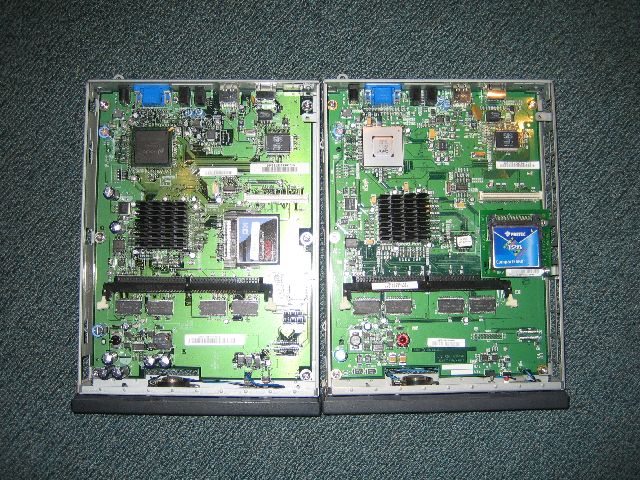
The 16mb flash card in the WXX contains Windows CE although this doesn’t work on the EXX model. Apart from that (and the small motherboard differences) the systems are almost identical. Each system has a Cyrix MediaGX subsystem (Video and CPU).
- CPU at 233MHz with 16k L1 memory (no L2)
- 3mb shared video card (up to 1280x1024)
- 32mb ram on board with a standard SDRAM slot, which can handle up to 256mb (288mb total)
- Compact Flash slot
- Ethernet
- 2x USB 1.1
- External power brick
- Microphone and Headphone slots
- Small internal speaker
- Completely silent, no fans (CRT monitor makes more noise)
Linux-2200 is a very basic Linux install based on Debian. It is quickly done and probably needs a little work. Here are some configuration changes I did to the system after I installed it. Make sure you make these changes to the flash card (and not the ram disc). Fixed the keyboard mapping as it is set to a German style keyboard.
- Delete the line “loadkmap < /key.map” from /etc/inti.d/rcS
- Remove /usr/X11R6/lib/X11/xkb
Changed the DNS settings
- change the IP address in /etc/resolv.conf to an ip address for your local (or ISP) DNS server
A quick note on performance
- System boots very quickly
- Runs happily on the base 32mb ram (although I’d recommend 64mb)
- XMMS plays mp3s without problems, although can skip if you are doing more than a few things
- Faster than I expected for a 233MHz Cyrix system with no L2 cache
There are some issues with Linux-2200, for example the web browser included (dillo) at its current version does not support CSS and many other things. I plan on getting firefox running on it, so I will update this page when/if it gets done. I would also like to redistribute Linux-2200 with some small changes (including the fixes above and firefox)
Other Software for the N2200
Other Links
Thu, 04 Aug 2005 3:48 PM
Here are some photos of one of my IBM Netvista N2200 8363 thin clients running a hacked version of linuxPhotos of thin client running
Michael Dale
I should write up a quick how to as the info on the site isn't great. I was very surprised at how fast the system runs.
Sun, 31 Jul 2005 4:29 PM
Updated Final Updated Spring Timetable
Michael Dale
| Monday | Tuesday | Wednesday | Thursday | Friday | |
|---|---|---|---|---|---|
| 8am | Work | ||||
| 9am | Introduction to Collaborative Systems (31472) Lec, 01 CB03.05.10 | Object-oriented Design (31469) Lec, 01 CM05B.01.11 | |||
| 10am | |||||
| 11am | Distributed Computing Architecture (31470) Lec, 01 CB02.04.13 | ||||
| 12pm | Introduction to Collaborative Systems (31472) MTP 07 CB02.06.35/CB10.03.450 | Object-oriented Design (31469) Itl, 03 CB10.03.450 | |||
| 1pm | |||||
| 2pm | Object-oriented Design (31469) Tut, 05 CB10.02.240 | Distributed Computing Architecture (31470) Tut, 05 CB10.04.470 | |||
| 3pm | |||||
| 4pm | Distributed Computing Architecture (31470) Itl, 05 CB10.02.420 | ||||
| 5pm | |||||
| 6pm | Networking 2 (31471) Itl, 02 CB10.03.240 | ||||
| 7pm | |||||
| 8pm | |||||
| 9pm |
I may do another half day of work (or on Fridays if needed).
Sat, 30 Jul 2005 5:53 PM
IBM thin clients
Michael Dale
Spending a bit of money this week! Argh. Anywho.
I picked up 5 IBM thin clients (because it was about the same price as one :p) off ebay the other day (IBM 8363 Netvista N2200).
They have a 233MHz CPU, 64mb SDRAM, Internal CF card slot (for client software), sound card, USB, Ethernet, and a 4mb video card. They can do network boot via PXE and they have also been hacked to support linux booting off the flash card. The linux distro includes XMMS and a Web browser.
They are almost silent and look pretty cool (and are really small). I haven't got them yet, I should get them late next week.
Some pictures: 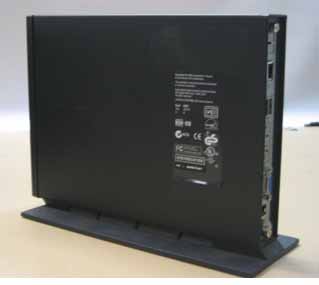
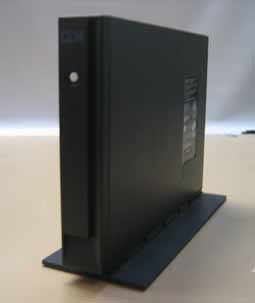
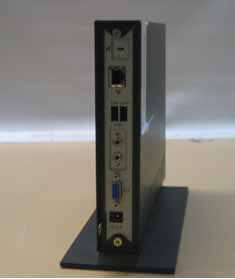
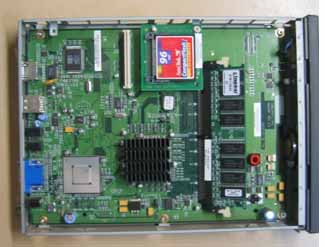
(check the keyboard to compare the size): A forum thread about getting linux to work on them
A forum thread about getting linux to work on them
Tue, 19 Jul 2005 10:07 PM
This post is following on from my entry about the servers hard drive dying and how I setup Raid 1.Setting up Raid 1 on FreeBSD 5.4
Michael Dale
During an automatic weekly backup, my web server's hard drive failed. Luckily I run a database backup nightly and had last weeks full backup.
I decided it was time to move to Raid. Raid 1 uses two hard drives to store your information. When one drive fails the other continues to operate allowing you to install a new drive and rebuild the array.
Please note, Raid is NOT a backup solution.
So I went and purchased two Seagate 80gb SATA hard drives. Since the motherboard doesn't have SATA support I also needed a SATA controller. I decided it was about time to move towards SATA and also the 80gb SATA drives come with an 8mb cache. The old hard drive in the server was the same model but in IDE form (and thus 2mb cache).
So I got home (from the Hunter Valley) on Saturday afternoon with two drives in hand. Later that day I got a PCI SATA controller based on an ALi m5283 chipset.
I plugged it in, setup the Raid 1 through the cards BIOS and loaded the FreeBSD 5.4 CD. I was greeted with the friendly message that no hard drives were detected, damn. I then did some googling and found that there really wasn't any support for this card outside of Windows. Great.
Anyway I needed a solution quickly and it was late. I needed to get a SATA controller from somewhere on Sunday. The only shop open close to me was Adelong and they had one SATA controller based on the Silicon Image 3112 chipset. Another quick google and from the looks of it FreeBSD supported the card.
So I got it home and plugged it in and setup another hardware raid (quasi hardware at least). Well FreeBSD loaded and showed me two hard drives. Interesting. With Raid 1 you should only see one. Looks like it supported the card, but not the raid function. Oh well I thought, software raid should do.
So a bit of google searching and some failed attempts at software raid I found this quick howto.
1. Install FreeBSD on to ad4.
2. Reboot with the Install CD.
3. Enter Fixit mode. (For FreeBSD less than 5.4, use Install CD disc2 as the “live filesystem”)
4. # chroot /dist
# mount_devfs devfs /dev
# gmirror load
# gmirror label -v -b round-robin gm0 /dev/ad4
# gmirror insert gm0 /dev/ad6
# mount /dev/mirror/gm0s1a /mnt
# echo ‘geom_mirror_load=”YES”‘ >> /mnt/boot/loader.conf # echo ’swapoff=”YES”‘ >> /mnt/etc/rc.conf
5. # sed “s%ad4%mirror/gm0%” /mnt/etc/fstab > /mnt/etc/fstab.new # mv /mnt/etc/fstab.new /mnt/etc/fstab
6. Reboot
Right looked easy. So I setup my first software raid and the system booted! Great.
I did a gmirror status gm0 and go this output:
gmirror status
Name Status Components
mirror/gm0 DEGRADED ad4 ad6(6%)
Gmirror was syncing up my second hard drive (ad6), so I decided to leave it for the night and headed to bed.
The next morning (Monday) I awoke to the follow error:
ad4:TIMEOUT - WRITE_DMA retrying (2 retries left)
The system was still online, but when ever there was any disc activity the system would lock for a few seconds before doing anything.
I did some searching and it seemed that the ATA drivers had some issues with SATA chipsets. Great.
Anyway there was a patch out for it, so I patched the system and recompiled the kernel. The system seemed to boot somewhat better. But I spoke too soon. As soon as I tried to copy over the backup image, gmirror reported that ad4 and ad6 were disconnected and the system locked up. Fantastic.
Another google search and it simply looks like the SiliconImage 3112 (Sil3112) is a piece of crap hardware. Don't buy one.
A quick call to Bryn and I had a lovely High Point RocketRaid 1520 card in my hands at about 5pm. Over three times more expensive than the first card I tried, and a much larger box, it was guaranteed to work! (also the fact that the card said FreeBSD support on the box :p).
I loaded it up, setup the raid through the bios and freebsd detected it as a hardware raid! Sweet.
Jul 19 21:21:48 metro kernel: ad4: 76319MB [155061/16/63] at ata2-master UDMA133
Jul 19 21:21:48 metro kernel: ad6: 76319MB [155061/16/63] at ata3-master UDMA133
Jul 19 21:21:48 metro kernel: ar0: 76319MB [9729/255/63] status: READY subdisks:
Jul 19 21:21:48 metro kernel: disk0 READY on ad4 at ata2-master
Jul 19 21:21:48 metro kernel: disk1 READY on ad6 at ata3-master
and
metro# atacontrol status ar0
ar0: ATA RAID1 subdisks: ad4 ad6 status: READY
four and a half days, 3 SATA controllers and many hours later, that night the server was online. :)
Tue, 07 Jun 2005 11:55 AM
It's true!Apple moving to Intel based CPUs
Michael Dale
So anyway, it is official. Apple is moving to Intel based CPUs, replacing the IBM G5 and the Motorola G4. So here is a quick run down of what is happening:
- First Apple computer with an Intel CPU by this time next year
- Majority of the transition within 2 years
- Developer Kits running a Pentium 4 3.6GHz PowerMac are available to developers NOW for $US999 and must be returned in 2007 (Ships with 10.4.1)
- Every operating system since OS 10.0.0 has worked internally on Intel CPUs
- Most Mac applications will work on the new CPU via a layer called "Rosetta"
- New version of Xcode (2.1) out now will compile for Intel CPUs
- Apple is not dropping support for the PowerPC
- There is nothing stopping the new Macs from running Windows, but OS X will not run on a standard PC.
Hopefully we'll see Pentium-M Laptops and NOT Celeron ibooks/imacs
Tue, 24 May 2005 10:18 PM
Ubuntu on PPC
Michael Dale
I decided to give Linux a shot again. I’ve never been a huge fan. Personally I feel much happier with BSD, but UNI runs Fedora Core 3 on most of the FIT computers so I felt I should give it a try again.
This time I didn’t feel like screwing around with installing Linux on my Athlon so I downloaded the live boot disc of Ubuntu version 5.04 for PPC (PowerPC) and booted it on my 12” 1.2GHz iBook.
To boot off a cdrom on the mac you need to hold down “c” as the system boots.
So anyway I’ve been using Ubuntu on my iBook for about 30 minutes and I thought I’d get down my first thoughts (I’ll probably write something more in detail later).
The system booted fairly quickly (remembering this is off a CD) and the first thing I noticed when Gnome (the default window manager for Ubuntu) appeared was that the mouse moved really quickly! Now when I say really quickly, I mean normal speed. Mac users take things slowly, so it was fast for ME!
Anyway the first test was network connectivity through the wireless card. Now I wasn’t really expecting it to work, considering it is a mac and all. Well it didn’t; no wireless. Aww. There is a good post about why it doesn't work here.
So I plugged in a network cable and turned on my network card and picked up an address via DHCP. Fired up firefox, working internet. Easy.
I then loaded “Music Player” and the first thing I noticed was that it seemed to support the iPod. So I plugged in my apple formatted iPod via firewire. Well it worked. The drive mounted and I could read all my music and files. Cool.
Only problem was that there is no MP3 support built in (or AAC for that mater). Oh well, not that hard to install.
apt-get couldn’t find some PPC binaries towards the end of the install but that didn’t really seem to break anything. MP3s now work, although the sound is really soft (and it is turned up to maximum).
I then decided to put the thing to sleep. The iBook quite happily went to sleep. So I went off to dinner. When I came back the laptop was still sleeping (good thing) so I opened it, bad idea. I got a blast of sound through the speakers, it didn’t stop. I quickly reset it (and no I didn't need to take the exploding iBattery out). Pity. There is a bit of information about it here
So I restarted back into Ubuntu to have a last play.
It is a bit hard to work with one button in Ubuntu; probably could bind the keys to something else, haven’t really looked.
Also the laptop seems to be working pretty hard. The fan does come on, which doesn’t happen much at all in OS X.
A part from those issues, it is fairly usable. The system runs really fast. I’m impressed. Video seems to work okay (the iBook has an ATi Radeon 9200, ATi aren’t known for their great linux support). I haven’t tried any 3D a part from the screen saver.
So final thoughts?
Would I use it?
No, not just yet. Lack of wireless and sleep support really make it hard to use for what I do. But saying that, I am impressed with the system. I wasn’t expecting much out of a mac version of linux, but it runs fine.
Hopefully in the future we’ll see better support for the mac hardware.
If I had an older mac that couldn’t run OS X then I’d probably seriously look at Ubuntu.
I think I could get to like Ubuntu, no wait I already like it. I’ll defiantly look at putting it on my PC which should have better support for everything.
Now there are probably ways around the problems I had, but I didn’t look all that hard into it. I did notice that the update system showed a new kernel version (not much use on a live CD) which might fix some stuff. But at the moment I’ll have to leave it.
